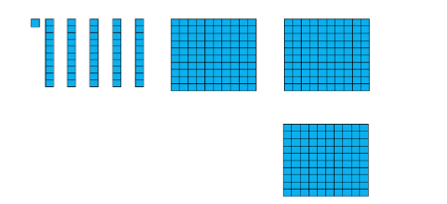General Information
Benchmark Instructional Guide
Connecting Benchmarks/Horizontal Alignment
Terms from the K-12 Glossary
- Expression
Vertical Alignment
Previous Benchmarks
Next Benchmarks
Purpose and Instructional Strategies
The purpose of this benchmark is to extend the understanding of place value from grade 1 to include reading and writing numbers up to 1,000 in various forms. The value of a digit is impacted by its position in a number (MTR.5.1).- Instruction includes the understanding that in expanded form each digit of a multi-digit number is assigned a value based on its place.
- Instruction includes experiences with numbers written in different forms.
- Instruction includes the use of both proportional and non-proportional models (i.e., base ten models or place value disks) (MTR.5.1).
Common Misconceptions or Errors
- Students may identify digits instead of naming their value.
- For example, students may say the value of the 4 in the number 142 is just 4, as in 4 ones.
- Students may misinterpret the value of the ones, tens or hundreds digit as the number of
ones, tens or hundreds.
- For example, students may say that there are 40 tens in the number 142.
- Students may have difficulty expressing numbers with zero tens.
- Students may incorrectly record the standard form based on word form.
Strategies to Support Tiered Instruction
- Instruction includes the use of base-ten blocks and a place value chart. The teacher asks students to build the number using base-ten blocks on a place value chart. Then, asks them to write the number (standard form). If they write 25, teacher asks about how many of each place value and rewrites the number while discussing the value of the hundreds, tens and ones.
- Instruction includes using base-ten blocks and a place value chart to represent a 3-digit number (e.g., 365 can be represented by 3 flats, 6 rods, 5 units).
- For example, teacher asks students to label the place value using the expanded form under the rods on the chart. (300 under the flats, 60 under the rods, 5 under the units). The teacher has students write out the word form using the expanded form to assist in writing it out. Finally, teacher asks students what the number would be in all forms if we removed 60?

Instructional Tasks
Instructional Task 1 (MTR.2.1)
Provide a series of three-digit modeled numbers using a base ten model like the one shown below.
Instructional Items
Instructional Item 1
Which of the following shows 613 in expanded form?Instructional Item 2a. 600+3b. 600 + 13c. 600+10+3
d. 500+90+33
Select all the ways to describe the number 809.
*The strategies, tasks and items included in the B1G-M are examples and should not be considered comprehensive.
